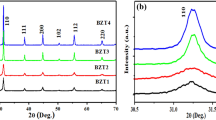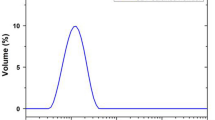Abstract
Ceramic nanocrystalline samples with composition Ba1−3aBi2aTiO3 were synthesized by sol–gel method, for different values of parameter a (for a = 0.0165, 0.033, 0.050). In order to determine whether barium bismuth titanate is suitable for application in temperature sensors, dielectric properties measurements were conducted on the prepared samples, as a function of both temperature (from room temperature up to 190 °C) and frequency (from 50 kHz to 1 MHz). Real and imaginary parts of dielectric constant were determined using an Impedance Analyzer HP-4194A. Depending on parameter a two different behavior were determined: (1) classical ferroelectric behavior, for the sample with low a value and (2) relaxor behavior for the samples with higher a values. Thus, a typical characteristic of relaxor ferroelectrics with a broad and dispersive dielectric maximum was observed for the samples Ba0.85Bi0.1TiO3 and Ba0.90Bi0.066TiO3. Temperature dependence (for real part of dielectric constant εr′) is almost linear, for lower temperatures than peak value (slope +1.3 1/ °C), and higher than this value (slope −1 1/ °C). The feature of linearity is very important from practical aspects of application of this material in wireless temperature sensors. The temperature coefficient of dielectric constant for the sample with the best linearity (Ba0.95Bi0.033TiO3 at 1 MHz) was found to vary from positive one +3.72 × 10−3 1/ °C to negative value −2.85 × 10−3 1/ °C, in the temperature range 25–190 °C.









Similar content being viewed by others
References
D. Hennings, Int. J. High. Technol. Ceram. 3, 91–111 (1987)
B.D. Stojanovic, C.R. Foschini, M.A. Zaghete, F.O.S. Veira, K.A. Peron, M. Cilense, J. Varela, J. Mater. Process. Technol. 143–144, 802–806 (2003)
A. Shukla, R.N.P. Choudhary, A.K. Thakur, J. Phys. Chem. Solid 70, 1401–1407 (2009)
A. Metzmacher, K. Albertsen, J. Am. Ceram. Soc. 84, 821–826 (2001)
H. Ihring, J. Am. Ceram. Soc. 64, 617–620 (1981)
L.E. Cross, Ferroelectrics 151, 305–320 (1994)
C. Miranda, M.E.V. Costa, M. Avdeev, A.L. Kholkin, J.L. Baptista, J. Euro. Ceram. Soc. 21, 1303–1306 (2001)
X.S. Gao, J.M. Xue, Y. Ting, Z.X. Shen, J. Wang, Ceram. Int. 30, 1361–1364 (2004)
D. Popovici, M. Okuyama, J. Akedo, Ferroelectrics—Mater. Aspects Tech. 1, 279–304 (2011)
F. Bahri, H. Khemakhem, A. Simonb, R. Von Der Mühll, J. Ravez, Solid State Sci. 5, 1235–1238 (2003)
A.M. Azad, S. Subramaniam, Mater. Res. Bull. 37, 11–21 (2002)
A. Chaouchi, S. Kennour, S. d’Astorg, S. Marinel, M. Aliouat, Process. Appl. Ceram. 4, 75–80 (2010)
M. Unger, G. Radosavljević, W. Smetana, Lj. Živanov, and T. Koch, 32nd International Spring Seminar on Electronics Technology: Hetero System Integration, the path to New Solutions in the Modern Electronics, 2009
G. Stojanović, V. Srdić, M. Maletin, Phys. Status Solidi A 205, 2464–2468 (2008)
J. Bobić, M. Vijatović, T. Rojac, B. Stojanović, Process. Appl. Ceram. 3, 9–12 (2009)
D.B. Jannet, M. El Maaoui, J.P. Mercurio, J. Electroceramics 11, 101–106 (2003)
N. Vittayakorn, J. Appl. Sci. Res. 2, 1319–1322 (2006)
S. Wada, K. Yamato, P. Pulpan, N. Kumuda, B.Y. Lee, T. Iijima, C. Moriyoshi, Y. Kuroiwa, J. Ceram. Soc. Jpn. 118, 683–687 (2010)
Acknowledgments
This work was partly supported by the Ministry of Education and Science, Republic of Serbia, through the project III45021 and COST MP0904 Project SIMUFER.
Author information
Authors and Affiliations
Corresponding author
Rights and permissions
About this article
Cite this article
Cvejin, K., Mojić, B., Samardžić, N. et al. Dielectric studies of barium bismuth titanate as a material for application in temperature sensors. J Mater Sci: Mater Electron 24, 1243–1249 (2013). https://doi.org/10.1007/s10854-012-0914-3
Received:
Accepted:
Published:
Issue Date:
DOI: https://doi.org/10.1007/s10854-012-0914-3




